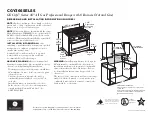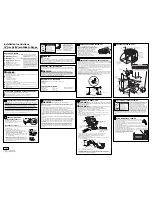
13
BEFORE SETTING SURFACE CONTROLS
Using Proper Cookware
The size and type of cookware used will influence the heat
setting needed for best cooking results. Be sure to follow
the recommendations for using proper cookware as illus-
trated in
and
.
Cookware Selection
Cookware selection is especially important when using an
induction cooktop. The cookware must contain magnetic
iron or steel to work on an induction cooktop. Common
materials for induction cookware include the following:
•
Stainless Steel
- Slow heat conductor with uneven
cooking results. Durable, easy to clean, and resists
staining. Some types of stainless steel will not work on
an induction cooktop. Use the magnet test (
check stainless steel cookware.
•
Cast Iron
- A slow heat conductor that retains heat very
well. Cooks evenly once cooking temperature is
reached.
•
Porcelain-enamel on metal
- Heating characteristics
will vary depending on base material. Porcelain-enamel
on a magnetic metal will work on an induction cooktop.
Use the magnet test (
) to check porcelain-
enamel cookware.
The Magnet Test
To see if a piece of cookware will work on your induction
cooktop, try to stick a magnet to it (see
).
If the magnet clings firmly to the bottom of the cookware, it
will work on your induction cooktop. If the magnet clings
weakly or not at all, the cookware will not heat up on your
induction cooktop.
Check for flatness by rotating
a ruler across the bottom of
the cookware (see
Cookware should have flat
bottoms that make good
contact with the entire surface
of the cooking zone (see
Figure 2:
Ruler test
Figure 3:
Magnet test
Induction-ready
cookware will often
have a symbol printed
on the bottom by the
manufacturer.
Figure 4:
Induction symbol
Proper cookware on an operating induction cooking zone
will heat up very quickly. If an empty piece of cookware is
left on an operating induction cooking zone, the rapid
change in temperature may warp or damage the
cookware.
Magnet
Sticks
Magnet
Falls
CAUTION














































